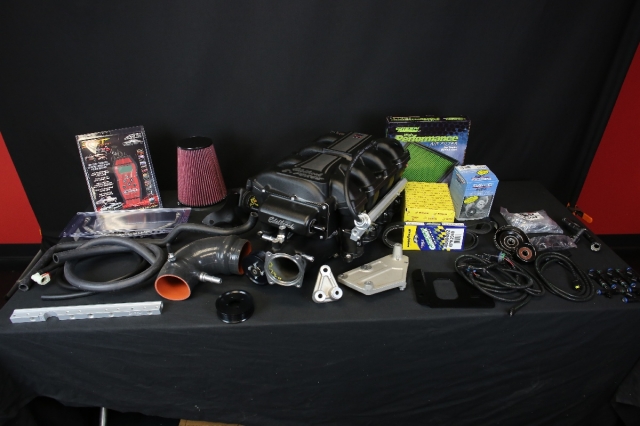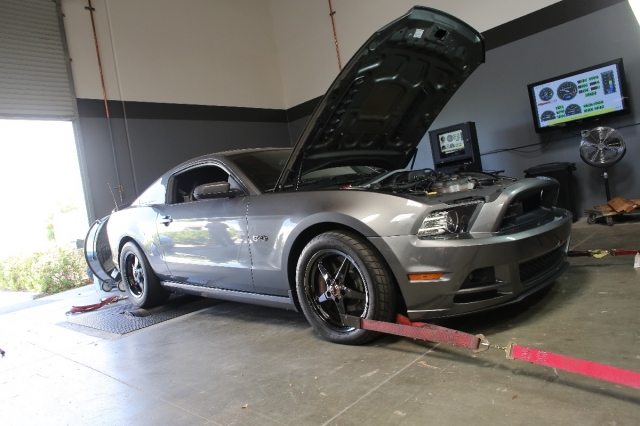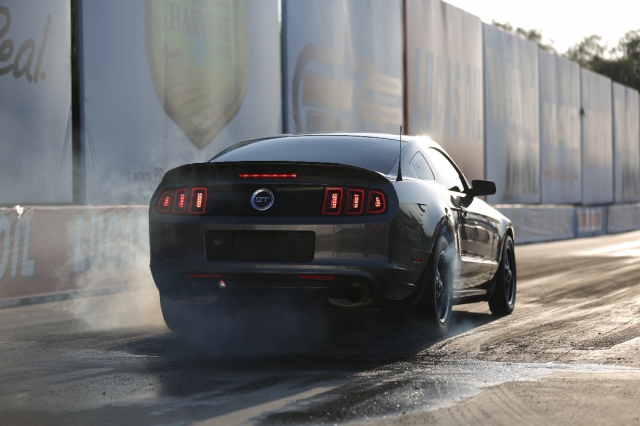It is undeniable that modular platform Ford engines respond well to forced induction. This has been apparent in the Mustang market since 1996. Several years ago Edelbrock stepped into the supercharger market with their line of E-Force superchargers. Taking everything they’ve learned about performance and induction systems over the last 75 years and packaging it into systems for many modern muscle car engines, including the current 5.0 Coyote.
When we got a chance to get our hands on an Edelbrock Stage 2 E-force system and a 2013 Mustang GT for testing, we couldn’t resist. Follow along as we install and test the E-Force system not just at the shop on they dyno, but also in the real world – at the drag strip.
Proven Package
We wanted to make sure the system was compact so that it would be an option for those who are considering using a supercharger on a Coyote engine swap into another vehicle. -Eric Blakely, Edelbrock
The E-Force supercharger system is based on the Eaton TVS 2300 Gen VI supercharger rotor package. This supercharger package uses twisted four-lobe rotors that generate boost quickly and efficiently, and force a massive volume of air into the engine.
The E-Force package for the Coyote evolved out of Edelbrock’s previous success with the 4.6 three-valve engine used in S197 Mustangs until the new 5.0 made it’s debut for 2011. “Ford sent us early CAD data on the Coyote and we were able to get a head start on our design,” says Edelbrock’s Eric Blakely.
According to Blakely the early CAD data showed that much of what worked in terms of packaging the E-Force for the 4.6 would also work with the new 5.0.
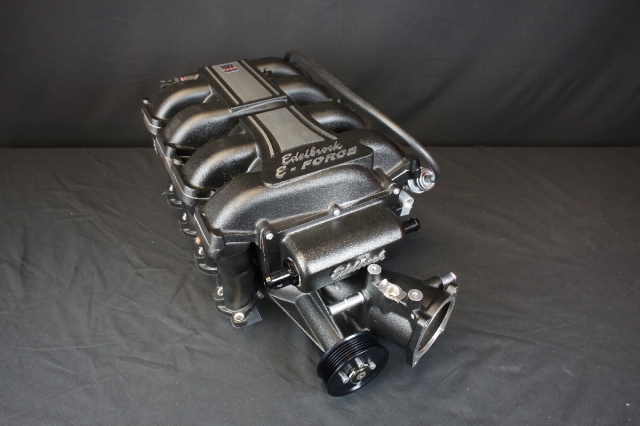
Based around the Eaton TVS Gen VI Rotor Package, the E-Force Supercharger builds boost quickly and is able to maintain it throughout the RPM range. The supercharger and intake manifold are integrated into a single package.
Integrated Design
Inverted Supercharger Benefits
Inverting the supercharger also allows for an incredibly long runner length of 15-inches. While roots style superchargers are traditionally known for their low end torque already, the additional runner length of the E-Force system further improves top end power where boost is known for falling off.
Edelbrock uses the Eaton TVS rotors, but packages them different than many other supercharger systems based on the TVS. Edelbrock uses their own housing. This housing design actually inverts the supercharger, which places it low in the engine valley instead of adding height to the engine.
Additional features of the E-Force design include a front drive and front inlet, giving incoming air a short, and straight path into the supercharger with minimal restriction.
This design, like most roots style superchargers, allows for the use of an air-to-water intercooler system. Since the supercharger is an inverted design, the intercooler actually sits above the supercharger. Packaging the intercooler on top allows for a massive 110 square inches of intercooler area, further improving efficiency.
The packaging is something that Blakely says was particularly important to Edelbrock, “We wanted to make sure the system was compact so that it would not only fit under the hood of the Mustang but also that it would be an option for those who are considering using a supercharger on a Coyote engine swap into another vehicle.”
While all of these benefits and engineering feats are impressive, the E-force has one other benefit – the supercharger and intake manifold are integrated into one complete assembly. This means there is not a separate intake manifold and supercharger that must be assembled. Everything is put together at Edelbrock’s California manufacturing facility. Combining the two assemblies eliminates the number of seals and gaskets present in the system, reducing the potential for parts failures and leaks. This also makes the installation process that much easier.
Left: A heat exchanger for the intercooler as well as the necessary plumbing and an electric water pump are also included with the E-Force kit. Right: The stage 2 kit includes this cold air induction system with an open element filter, the smaller diameter 3.25-imch pulley is already installed on the supercharger from Edelbrock.
What’s Included
Edelbrock has recently moved to repackage their E-Force systems into a manner that’s easier for most enthusiasts to understand. The Stage 1 system for the Coyote will typically produce 5-6 psi of boost and is CARB approved, making it legal for use in all 50 states. Stages 2 and 3 step things up further in the boost department and don’t carry CARB approval.
We ordered the Edelbrock E-force system in stage 2 trim, part number 15896. This kit is very similar to part number 1588 which is the Stage 1 kit. The primary differences between the two kits are that the stock air filter box is replaced with an open air element filter for cold-air induction with less restriction, and a different (smaller) 3.25-inch diameter pulley is already installed on the supercharger. Edelbrock provides an updated tune for this particular package to take into account the additional boost and air volume. Those with E-Force system 1588, Stage 1 already installed on their car can order part number 15882 to upgrade to the Stage 2 system.
Left: The first step in installation is to remove the front bumper. Center Left: To keep the air charge as cool as possible the heat exchanger is mounted in front of the radiator and the AC condenser. Center Right: We mounted the heat exchanger water pump and connected the hoses. Right: This piece of plastic must be cut in order to route the fluid lines for the heat exchanger.
The Stage 2 system should produce 8-9 psi of boost and while those are relatively low sounding numbers to many enthusiasts, Blakely tells us that E-Force systems are intended to make big power with low boost, allowing them to be compatible with stock engine internals. “Making power at lower levels of boost, makes the system compatible with stock engines, so the average enthusiast doesn’t have the additional expense of a crate engine, or building an engine to handle the boost,” says Blakely.

Our test car was already equipped with a Ford Racing BOSS intake manifold, which will be replaced by the E-Force system.
The stage two system also includes the following parts:
- New serpentine belt
- 50 lbs/hr fuel injectors
- 3.25-inch supercharger pulley
- Edelbrock extruded aluminum fuel rails
- Plug and play electrical harness
- Heavy duty automatic belt tensioner
- Steel idler pulleys with heavy-duty bearings
- Electronic intercooler water pump
- Custom molded hoses
- Integrated bypass valve
- 100,000 mile self-contained oiling system
- Optional 3 year 36,000 mile or 5 year 100,000 mile year warranties available.
Simple Installation
Edelbrock has detailed, full color instructions for installation of the E-Force, and all of the parts, and hardware are labeled and bagged accordingly. This makes hunting for the right pieces a little easier, and installation that much smoother.
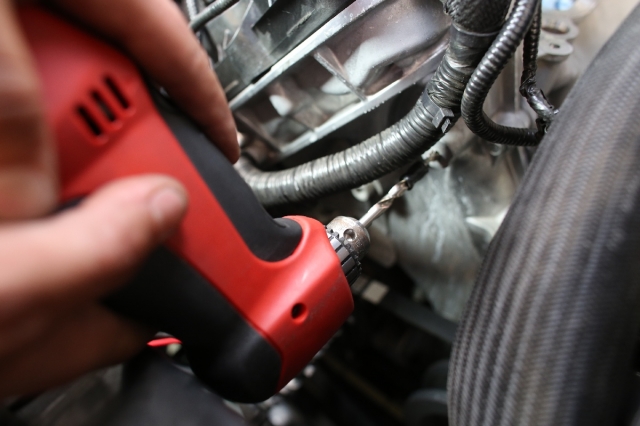
In order to install the included heavy duty belt tensioner, three existing holes in the front timing cover must be drilled and tapped.
Since the E-Force supercharger is designed to replace the car’s original intake manifold, installation is straightforward. DIY’ers looking to install this at home will need either access to a lift or a jack and stands to get everything connected. It is also worth noting that the front bumper assembly must be removed from the car in order to install the heat exchanger for the supercharger’s intercooler.
Much of the rest of the installation is similar to an intake manifold swap, since the E-Force supercharger integrates the intake and charger into one unit. There are a few exceptions that require some intermediate fabrication skills. A hole must be cut in a plastic deflector on the front of the car in order to route one of the coolant lines for the intercooler and heat exchanger. Also on manual transmission cars two of the AC hard lines must be slightly bent to accommodate the water pump for the heat exchanger. On automatic cars there is only one of these lines.
Top Left: With the gaskets in place the E-Force assembly is carefully set into place. The bolts are torqued to 8 ft-lbs in a criss-cross pattern from the inside-out. Edelbrock outlines this specifically in the instructions with a diagram. Top Right: A new fuel rail crossover line is supplied with the E-Force. Bottom Left: Injectors are transferred to the fuel rail. Bottom Right: The bypass valve actuator must be loosened to allow the injectors and fuel rail to be installed. The rails will also need the supplied alignment clips installed.
There are three holes on the passenger’s side of the timing cover that will need to be drilled and tapped using the supplied bit and M8 tap. One of these holes requires inspection to ensure that it was not already tapped at the factory. This step is necessary to install the new belt tensioner, and requires the use of a 90 degree, right angle drill.
The belt routing changes slightly on the engine since the supercharger is driven off the engine’s serpentine belt, the same one that also runs the alternator, AC compressor and water pump. Edelbrock supplies a new belt routing diagram with their instructions.
With the plug and play wiring harnesses installed, and the cold air intake in place, all that's left is to load the tune, fill the coolant, and test it on the dyno.
Tuning
Edelbrock includes an SCT handheld flash tuner with the E-Force supercharger that will load the proper calibration to the engine control module. It is necessary to download the engine’s stock file first. If the computer has been previously flashed with a performance tune it will need to be returned to stock prior to loading the Edelbrock tune.
The proper tune for the specific vehicle must be downloaded from Edelbrock. To do this there are steps which will give a seven-digit strategy or CAL number to reference so that Edelbrock sends the proper file. There is also a disclaimer form that must be completed. Edelbrock will then send the proper file to the end user which can be loaded. This needs to be done before trying to start and run the car with the E-Froce supercharger installed.
Since our test car already has a variety of bolt-on modifications, including long tube headers and a larger throttle body, the air/fuel ratios of the Edelbrock tune weren’t compatible. So we turned to our friends at Brenspeed for a custom tune using SCT software. Brenspeed has been dealing with Edelbrock E-Force superchargers of all levels for as long as Edelbrock has been selling them. Since Brenspeed has experience with building cars, and working with customer cars on a daily basis that are typical of ours, they were able to provide us with a tune that would maximize the performance of all modifications the car has including the new E-Force supercharger. The custom tune also optimizes the air/fuel ratio to make sure everything stays safe and keeps the engine healthy.
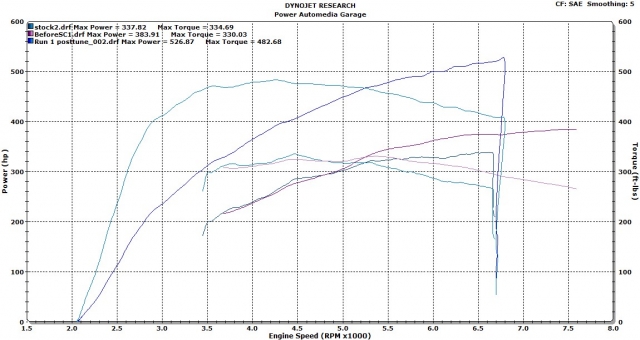
An increase of 189.0 hp and 147.9 lb-ft over stock. Though we have to mention that the Mustang also has a header-back and an Accufab throttle body. During it’s previous modification stage the Mustang also had a BOSS 302 intake manifold, cold air intake, and custom tune. Gains over those mods netted 142.9 hp and 152.6 lb-ft.
Dyno Testing
Making power at lower levels of boost, makes the system compatible with stock engines, so the average enthusiast doesn’t have the additional expense of a crate engine, or building an engine to handle the boost. -Eric Blakely, Edelbrock
We performed baseline dyno testing on our 2013 Mustang GT test car. The test car has some typical bolt on parts common to many Coyote equipped Mustang owners including a Ford Racing BOSS intake manifold, a full exhaust system including long-tube headers, an Accufab throttle body, 3.73 ring and pinion, and a custom tune.
The stock automatic car made 337.8 hp and 334.6 ft-lbs of torque. With the bolt-on mods, before we began the E-Force supercharger installation, the car made 383.9 hp and lost a little bit of torque that’s common with a BOSS 302 intake. Once our installation was completed and the flash tune loaded, we again strapped the car to the Power Automedia in-house Dynojet and spun the rollers. With the E-Force in place, the car made an impressive 526.8 hp and 482.6 ft-lbs. This was a gain of 142.9 hp in addition to the bolt-ons, and 189.8 hp and 147.9 ft-lbs total power gains over stock.
Power under the curve, something we often emphasize that enthusiasts should pay even more attention to than perhaps peak power numbers were also solid. With the E-Force Stage 2 installed, at 3,500 rpm where the test started for the two previous dyno runs on record, the engine is already making near peak torque. Horsepower is also up significantly from this point all the way to redline, though the Edelbrock tune uses a factory redline versus the custom tune when naturally aspirated that extended an additional 500 rpm. By 4,000 rpm the boosted engine has already exceeded the bolt-on only test peak, and that’s still 2,700 rpm to go before hitting the rev limiter.
Drag Testing
Big power gains are great, but it can be difficult to equate those numbers to real world scenarios. Since the drag strip provides a great real-world testing grounds for how well the car performs with modifications we hit the strip before and after this installation. Previously the car ran a best eighth-mile of 7.74 at 92.11 mph. At the drag strip the car was launched at just 1,500 rpm on with drag radials on the back. The best ET with the E-Force installed was 7.05 at 97.53 mph, an improvement of just shy of .7 seconds in the eighth mile. Even going down the track we were surprised at how quiet the E-Force supercharger is. With the engine howling and boost building the car is not only faster on the track, but feels faster as well. Anything more than a 1,500 rpm launch and the car would need a better suspension setup than the typical bolt-on control arms it already has, and possibly slicks.
On The Street
On the street the E-Force gives excellent drivability. Idling, or driving in SoCal traffic it’s practically invisible. Put your foot down on the throttle and the response is instant as the E-Force builds maximum boost at low RPM, and thanks to the design of the TVS rotors, it maintains that boost pressure all the way to redline, feeding the Coyote a steady diet of compressed air. The supercharger is surprisingly quiet, in fact unless you’re looking for the sound you don’t even notice it’s there. The automatic transmission makes rolling into the power easy, and the engine’s response to throttle inputs is much snappier. Roll into the a little too quick and the E-Force will let you break the tires loose at will all day long. While the car was fun with just the bolt-ons, it’s a whole new animal with the E-Force onboard.
Whether your car is a daily driver, or a weekend track warrior, the Edelbrock E-Force Supercharger for 2011-2013 Mustangs offers uncompromising drivability and impressive performance, in a package that any competent enthusiast can install over a weekend, and enjoy on the commute to the office Monday morning.




